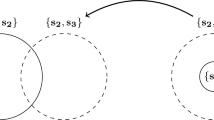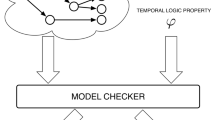Abstract
A partitional model of knowledge is monotonic if there exists a linear order on the state space such that, for every player, each element of her partition contains only a sequence of consecutive states. In monotonic models, the absence of alternating cycles is equivalent to the property that, for every pair of players, the join of their partitions contains only singletons. Under these equivalent conditions any set of posteriors for the players is consistent (i.e., there is a common prior). When checking for consistency in a monotonic model, it is not necessary to evaluate all cycle equations; if the cycle equations corresponding to cycles of length two hold, then there is a common prior.

Similar content being viewed by others
Notes
Harsanyi type spaces are models such that each player has one of many possible types, the state space is the Cartesian product of all sets of possible types, and partitions are such that each player knows only her own type. The condition imposed by Hellwig (2013) makes his class of models more general than Harsanyi spaces because he requires only that for every pair of players \(i,j\) and every element \(\pi ^{i}\) of \(i\)’s partition and \(\pi ^{j}\) of \(j\)’s partition, then \(\pi ^{i}\cap \pi ^{j}\ne \varnothing \). Intuitively, Harsanyi spaces could be imagined as hyperrectangles (generalization of rectangles for higher dimensions), while a monotonic model could be imagined as a line.
If a model has a cycle \(c\), then there is an alternating cycle. If \(c\) is alternating we are done. Otherwise, by the definition of cycle, part (ii), the cycle \(c\) contains consecutive edges \(\left\langle j;\omega _{1}^{\prime },\omega _{2}^{\prime }\right\rangle , \left\langle j;\omega _{2}^{\prime },\omega _{3}^{\prime }\right\rangle \),\(\ldots , \left\langle j;\omega _{s-1}^{\prime },\omega _{s}^{\prime }\right\rangle , \left\langle j^{\prime };\omega _{s}^{\prime },\omega _{s+1}^{\prime }\right\rangle \) such that \(s\!\ge \! 3\) and \(j\!\ne \! j^{\prime }\). Because states \(\omega _{i}^{\prime }\) and \(\omega _{i+1}^{\prime }\), for \(i\!=\!1,\ldots \!,s\!-\!1\), belong to the same element of \(\Pi ^{j}\), then \(\omega _{1}^{\prime }\) and \( \omega _{s}^{\prime }\) belong to the same element of \(\Pi ^{j}\). Define the cycle \(c^{\prime }\) from \(c\) by replacing the collection of edges \( \left\langle j;\omega _{1}^{\prime },\omega _{2}^{\prime }\right\rangle , \left\langle j;\omega _{2}^{\prime },\omega _{3}^{\prime }\right\rangle \),\( \ldots , \left\langle j;\omega _{s-1}^{\prime },\omega _{s}^{\prime }\right\rangle \) by \(\left\langle j;\omega _{1}^{\prime },\omega _{s}^{\prime }\right\rangle \). If the result is alternate, we are done. Otherwise, repeat the process. This process decreases the number of edges in cycle. Because \(c\) has only finitely many edges, eventually, the resulting cycle will be alternate.
To obtain consistency it suffices to check cycle equations associated with alternating cycles. This is true because if all cycle equations in this subset hold, all other cycle equations must also hold. Indeed, every equation associated to a cycle that is not alternating has one or more common factors on both sides. After cancelling out all of these factors, the resulting equation becomes equal to a cycle equation of an alternating cycle. For instance, if a cycle \(c\) has the \(j\)-edges \(\left\langle j;\omega _{0},\omega _{1}\right\rangle \) and \(\left\langle j;\omega _{1},\omega _{2}\right\rangle \), the factor \(\theta _{\omega _{1}}^{j}\) appears in both sides of its cycle equation. By cancelling this common factor, the simplified equation corresponds to the cycle obtained from \(c\) by replacing \( j\)-edges \(\left\langle j;\omega _{0},\omega _{1}\right\rangle \) and \( \left\langle j;\omega _{1},\omega _{2}\right\rangle \) and their opposites with, respectively, \(\left\langle j;\omega _{0},\omega _{2}\right\rangle \) and its opposite.
The \(j\)-edges of \(\vec {G}\) inside each element \(\pi _{r}^{j}\) of partition \( \Pi ^{j}\) connect, directly or indirectly, all nodes in \(\pi _{r}^{j}\). For every pair of distinct nodes of each \(\pi _{r}^{j}\), there is a unique increasing path of \(j\)-edges of \(\vec {G}\) connecting them.
Formally, \(-x\) is not a \(j\)-edge of graph \(\vec {G}\), but it is a \(j\)-edge of the meet-join diagram, and it belongs to the edge space, \(V(\vec {G})\). See more details about edge spaces and cycle spaces in Rodrigues-Neto (2012).
Function \(F\) might not be unique, but the argument stands.
If we were to insist in writing a cycle equation for the closed path \( \{\left\langle j;\omega _{i},\omega _{i+1}\right\rangle ,\left\langle j;\omega _{i+1},\omega _{i}\right\rangle \}\), this equation would be trivial: \(\theta _{\omega _{i+1}}^{j}\cdot \theta _{\omega _{i}}^{j}=\theta _{\omega _{i}}^{j}\cdot \theta _{\omega _{i+1}}^{j}\).
References
Aumann R (1976) Agreeing to disagree. Ann Stat 4:1236–1239
Aumann R (1999) Interactive epistemology I: knowledge. Int J Game Theory 28:263–300
Feinberg Y (2000) Characterizing common priors in the form of posteriors. J Econ Theory 91:127–179
Harsanyi JC (1967–1968) Games with incomplete information played by Bayesian players, I, II, III. Manag Sci 14:159–182, 320–334, 486–502
Hellwig M (2013) From posteriors to priors via cycles: an addendum. Econ Lett 118:455–458
Morris S (1994) Trade with heterogeneous prior beliefs and asymmetric information. Econometrica 62:1326–1347
Rodrigues-Neto JA (2009) From posteriors to priors via cycles. J Econ Theory 144:876–883
Rodrigues-Neto JA (2012) The cycles approach. J Math Econ 48:207–211
Rubinstein A (1989) The electronic mail game: strategic behavior under almost common knowledge. Am Econ Rev 79:385–391
Samet D (1998a) Common priors and the separation of convex sets. Games Econ Behav 24:172–174
Samet D (1998b) Iterated expectations and common priors. Games Econ Behav 24:131–141
Acknowledgments
I would like to thank Simon Grant, Scott McCracken, James Taylor, Ronald Stauber, two anonymous reviewers, and seminar participants at the Australian National University and at the Australasian Economic Theory Workshop at the University of Melbourne, for comments. I would like to thank Merrilyn Lárusson for the English editing. All remaining errors are my own responsibility.
Author information
Authors and Affiliations
Corresponding author
Appendix: Proofs
Appendix: Proofs
1.1 Proof of Proposition 1
In a monotonic model, suppose that, for every pair of different partitions \(\Pi ^{j}\ne \Pi ^{j^{\prime }}\), their join contains only singletons; \(\Pi ^{j}\vee \Pi ^{j^{\prime }}=\{\{\omega \}\left| \right. \omega \in \Omega \}\). Then, there is no pair of different states belonging to the same element of \( \Pi ^{j}\) and also to the same element of \(\Pi ^{j^{\prime }}\). In particular, there are no two consecutive states belonging to the same element of \(\Pi ^{j}\) and, at the same time, belonging to the same element of \(\Pi ^{j^{\prime }}\). This means that there is no cycle of length two; i.e., \(\mathfrak I ^{*}\) is empty. Hence, this monotonic model is acyclic because, by Proposition 3, the existence of any cycle would imply the existence of a cycle of length two.
Conversely, suppose that there is no alternating cycle. Let \(j_{1}\ne j_{2}\in J\) be two arbitrary players. Suppose by contradiction that there are two distinct states \(\omega _{1}\) and \(\omega _{2}\) in the same element of the join \(\Pi ^{j_{1}}\vee \Pi ^{j_{2}}\). Because the join is a refinement of \(\Pi ^{j_{1}}\), then, \(\omega _{1}\) and \(\omega _{2}\) belong to the same element of \(\Pi ^{j_{1}}\). Hence, the meet-join diagram has the \( j_{1}\)-edge \(\left\langle j_{1};\omega _{1},\omega _{2}\right\rangle \). Similarly, \(\omega _{1}\) and \(\omega _{2}\) are in the same element of \(\Pi ^{j_{2}}\), and the meet-join diagram has the \(j_{2}\)-edge \(\left\langle j_{2};\omega _{2},\omega _{1}\right\rangle \). Consider the path \( c=\{\left\langle j_{1};\omega _{1},\omega _{2}\right\rangle ,\left\langle j_{2};\omega _{2},\omega _{1}\right\rangle \}\). Clearly, \(c\) is an alternating cycle, which contradicts the hypothesis.
If in a monotonic model all joins of two players have only singletons, there is no cycle. By Rodrigues-Neto (2009), all posteriors of are consistent; that is, there is a common prior.
1.2 Proof of Proposition 2
If there is no cycle, the result is trivial. Consider any arbitrary cycle \(p\) of arbitrary length \(k\ge 2\). Without loss of generality (see footnote \(5\)), \(p\) is an alternating cycle. Fix any arbitrary strict linear order \(\succ \) on \(\Omega \) that makes the model monotonic. Let \(U_{0}\) be the set of edges \( \left\langle j;\omega _{\alpha },\omega _{\beta }\right\rangle \) of cycle \(p\) such that \(\omega _{\beta }\succ \omega _{\alpha }\). Let \(D_{0}\) be the set of edges \(\left\langle j;\omega _{\alpha },\omega _{\beta }\right\rangle \) of cycle \(p\) such that \(\omega _{\alpha }\succ \omega _{\beta }\). Because cycle \(p\) is a closed path, \(U_{0}\ne \varnothing \) and \(D_{0}\ne \varnothing \). Let \(U\) be the multiset of edges obtained from the edges of \( U_{0}\) in the following way: for each edge \(\left\langle j;\omega _{\alpha },\omega _{\beta }\right\rangle \in U_{0}\), include in \(U\) the edges \( \left\langle j;\omega _{1},\omega _{2}\right\rangle , \left\langle j;\omega _{2},\omega _{3}\right\rangle , \ldots , \left\langle j;\omega _{k-1},\omega _{k}\right\rangle \), such that \(\omega _{1}=\omega _{\alpha }\) , \(\omega _{k}=\omega _{\beta }\), and for every \(i\in \{1,\ldots ,k-1\}, \omega _{i+1}\) and \(\omega _{i}\) are consecutive according to \(\succ \), with \(\omega _{i+1}\succ \omega _{i}\). The monotonicity of the model implies that \(\omega _{1}, \omega _{2}, \ldots , \omega _{k}\) belong to the same element of player \(j\)’s partition. Hence, every \(\left\langle j;\omega _{i},\omega _{i+1}\right\rangle \) belongs to the meet-join diagram. Construct a multiset \(D\) from the set \(D_{0}\) in an analogous way. It is crucial to define \(U\) and \(D\) as multisets (instead of sets), so they can include multiple copies of the same edge, if necessary. Because \(p\) is a closed path and because we defined \(U\) and \(D\) as multisets, they must always have the same number of elements, \(\left| U\right| =\left| D\right| \). Because \(U_{0}\ne \varnothing \) and \(D_{0}\ne \varnothing \), then \(U\ne \varnothing \) and \(D\ne \varnothing \). Because \( p \) is a closed path, there is a bijection \(F\) from \(U\) to \(D\) such that each edge \(u=\left\langle j_{U};\omega _{i},\omega _{i+1}\right\rangle \) of \( U\) is associated to edge \(F(u)=\left\langle j_{D};\omega _{i+1},\omega _{i}\right\rangle \) of \(D, j_{U}\ne j_{D}\), (edge \(u\) “moves up” from \( \omega _{i}\) to \(\omega _{i+1}\); edge \(F(u)\) “goes down” from \(\omega _{i+1}\) to \(\omega _{i}\)),Footnote 10 or else, in this process, there is a link between two consecutive states \(\omega _{i}\) to \( \omega _{i+1}\) such that \(j_{U}=j_{D}\). In the first case, every \(\{u,F(u)\}\) , for \(u\in U\), is a cycle of length two, and the collection of cycle equations corresponding to the collection of cycles \(\{\{u,F(u)\}\left| \right. u\in U\}\) generates the cycle equation corresponding to cycle \(p\). Hence, if all cycle equations corresponding to the collection of (length two) cycles \(\{\{u,F(u)\}\left| \right. u\in U\}\) are satisfied, the cycle equation corresponding to cycle \(p\) must also be satisfied. In the second case, there are edges \(u=\left\langle j;\omega _{i},\omega _{i+1}\right\rangle \in U\) and \(\left\langle j;\omega _{i+1},\omega _{i}\right\rangle \in D\), and then, \(\{u,F(u)\}\) is not a cycle, but only a closed path. Let \(Z\) be the sub-collection of \(\{\{u,F(u)\}\left| \right. u\in U\}\) such that each \(\{u,F(u)\}\) in \(Z\) is a cycle. This sub-collection has only cycles of length two (by construction) and is non-empty because \(p\) is a cycle. Moreover, if all cycle equations corresponding to cycles in \(Z\) are satisfied, the cycle equation corresponding to cycle \(p\) must also be satisfied.Footnote 11 In both cases, all cycle equations hold. Because \(\Omega \) is finite, then, by Rodrigues-Neto (2009), there is a common prior.
1.3 Proof of Proposition 3
This proof follows similar steps to those in the previous argument. Given any arbitrary cycle \(c\), the decomposition of \(c\) proposed in the Proof of Proposition 2 leads to cycles of length two belonging to the collection \(\mathfrak I ^{*}\). If \(\mathfrak I ^{*}\) is non-empty, it must contain a basis for the cycle space because the previous part of this proposition states that \(\mathfrak I ^{*}\) spans the cycle space. Every maximal linearly independent subset of \(\mathfrak I ^{*}\) is a basis for the cycle space. There is at least one maximal linearly independent subset of \(\mathfrak I ^{*}\) because the collection \(\mathfrak I ^{*}\) is non-empty and finite.
Rights and permissions
About this article
Cite this article
Rodrigues-Neto, J.A. Monotonic models and cycles. Int J Game Theory 43, 403–413 (2014). https://doi.org/10.1007/s00182-013-0385-7
Accepted:
Published:
Issue Date:
DOI: https://doi.org/10.1007/s00182-013-0385-7




